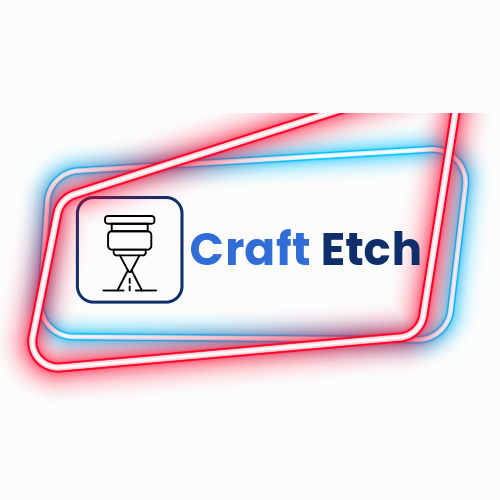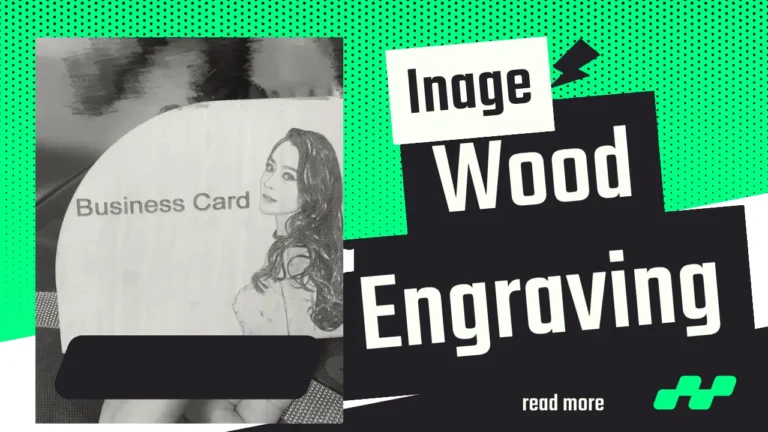Join Workshops
Physical Address
304 North Cardinal St.
Dorchester Center, MA 02124
3d Laser Engraving [Expert Guide] + [Proven Techniques]
3d laser engraving involves melting/removing material from the horizontal & vertical depth by the laser beam to visualize a particular design. Any powerful CO2, diode & fiber lasers can do it as the main complexity remains at the design end.
3D laser engraving is pretty similar to wood carving where a CNC machine cuts the wood from the depth to make a visible shape from the ground of the wood.
The old technique is just replicated with the help of CNC mechanism and laser precision that visualizes 3d objects at even a smaller workpiece.
In this article, we will focus on the following:
- How can you do 3d laser engraving?
- How would you set the accurate design/set the Lightburn canvas?
- What would you need to engrave in a 3d pattern?
- Other technical issues that affect engraving performances.
So, let’s begin!
How does 3d laser engraving work?
3d laser engraving combines carving technology, raster engraving design, and precision, which enables the laser beam to etch from the ground so that the design becomes life after the materials have been melted, or removed by the laser.
The process starts with a 3D model, which can be something as intricate as a personalized family portrait or as detailed as a topographical map.
This digital design is then programmed into the laser engraving machine with the help of workspaces such as Lightburn and XCS.
Typically, the laser acts like a pencil, tracing the design onto the chosen material, which can range from wood to metal to various types of plastics and even glass.
What sets 3D laser engraving apart from its 2D counterpart is the level of depth it can achieve. For example, a 2D image engraving would just look like a picture but when you turn that into 3d engraving, it becomes lively.
By adjusting the intensity and the focus of the laser beam, it can carve out fine details deeply into the material, adding shadows, textures, and layers that bring the image to life.
For instance, if you’re engraving a miniature landscape, the laser can create deeper cuts for the valleys and lighter ones for mountain peaks, giving a realistic tactile dimension to the scene.
If you are looking for a 3d laser engraver, ComMarker’s M7 can be a great choice that features a MOPA fiber laser module with 3d laser engraving capacity.
![3d Laser Engraving [Expert Guide] + [Proven Techniques] 1 ComMarker M7 MOPA FIBER LASER](https://craftetch.com/wp-content/uploads/2024/07/ComMarker-M7-MOPA-FIBER-LASER-1024x576.webp)
Steps of 3d laser engraving
Below are steps that help will help you start your first 3d engraving.
- Make a 3d grayscale image, or convert your image into 3d grayscale format (we will guide you further on how to convert the image into 3d grayscale shape)
- Send the 3d grayscale image to a laser workspace such as XCS or Lightburn
- Start engraving like you usually engrave
![3d Laser Engraving [Expert Guide] + [Proven Techniques] 2 3d laser engraving](https://craftetch.com/wp-content/uploads/2024/07/3d-laser-engraving-1024x576.webp)
How to make a 3d grayscale image for 3d engraving?
- Choose the image editing software. Select an image editing software that supports layers and can convert images to grayscale. Popular options include Adobe Photoshop, GIMP (a free alternative).
- Open the base image that you wish to convert into 3d grayscale image.
- Convert the image into grayscale. You can do this by going to
Image>Mode>Grayscale. In GIMP, navigate toImage>Mode>Grayscale. This will remove any color information and provide a monochromatic image. - Enhance contrast if needed. Use the
Brightness/ContrastorLevelstools to make the darks darker and the lights lighter, thus emphasizing the depth differences. - Create a depth map. Use a soft brush to paint different shades of gray where you want to represent different levels of depth. The lighter the area, the more elevated it will appear in the 3D space, and conversely, the darker the area, the lower it will appear.
- Try blurring for a smoother background. Applying a slight blur to the image. Use the
Gaussian Blurfilter sparingly to avoid losing too much detail. - Save your depth map as a separate file in a format that preserves the grayscale information without compression artifacts, such as PNG or TIFF.
- Import the grayscale image into your laser workpiece (in my case it’s Lightburn).
Setting Lightburn canvas
Remember, Lightburn alone cannot help you make a 3d carving. You first need to prepare your grayscale image in 3d format.
After you import the grayscale image into Lightburn you may need to adjust some settings manually.
Usually, for the darker area, the laser will use more power and for the lighter area, it will use less power. However, there are some options you may tweak a little bit to engrave your 3d pictures.
Again, depending on the laser type, the settings need to be changed.
For example, you can use a Co2 & powerful diode laser to 3d engrave wood and a fiber laser with heavy watts to engrave metal items such as Brass.
So, there are no accurate settings parameters for line depth, line interval or resolution (DPI). It depends on the material you are engraving or the laser that you are using.
For your help, we can list some Lightburn settings and their respective impact on the engraving.
- Power – The more you use it, the darker will it be.
- Speed – Higher speeds can lead to lighter engravings, as the laser spends less time in any one spot
- Pulse Frequency – It is applied to the fiber lasers. Higher frequencies can result in smoother engravings, while lower frequencies can produce a dotted or dashed effect.
- The number of passes – Multiple passes can be used to increase engraving depth or to cut through thicker materials.
- Air assist – When enabled, the air is blown onto the material being cut or engraved.
- Line interval – This setting controls the spacing between the engraving lines. A smaller line interval (higher DPI) will produce a more detailed image with finer shading, while a larger interval may be suitable for coarser, less detailed images.
- Z offset settings – This compensates for the laser beam’s kerf (width of the cut) to adjust the size of the engraved area for precise fitting, especially in inlay work.
So, 3d engraving is just an advanced way to engrave with your same old laser engraving machine.
Why grayscale image is required for 3d laser engraving?
A grayscale image is essential for 3D laser engraving because it provides the necessary information to create variations in depth that result in a three-dimensional effect.
In 3D laser engraving, the laser intensity and the time it spends on each point are regulated based on the shade of gray at that particular point in the image.
In a nutshell, how dark the image area is, will guide the laser about how much power it needs to use.
The grayscale image effectively acts as a map for the laser, telling it precisely where to engrave and how deep to go.
Indirectly, the grayscale map guides the laser to set the power accordingly and the variation of power acts like an advanced way of carving (which is exactly the opposite of etching).
Can you use a CO2 laser for 3d engraving?
![3d Laser Engraving [Expert Guide] + [Proven Techniques] 3 3d laser engraving using co2 laser](https://craftetch.com/wp-content/uploads/2024/07/3d-laser-engraving-using-co2-laser-1024x576.webp)
Yes, You can use a CO2 laser for 3d engraving wood, MDF crystal, and acrylic but the laser power needs to be more than 50 watts.
A few things your CO2 laser would need to have as well, such as:
- Air assist – for better airflow towards the engraving point so that the laser gets more oxygen and the air blows out the debris.
- Automatic Z-axis height adjustment feature – It enables the Co2 laser machine to adjust the height between the laser and the workpiece so that it can set the focus as required by the depth of the grayscale image.
- Motion accuracy (precision) – A lower precision such as 0.01 mm would help you to curve the material more accurately.
- Rotary attachment – To 3d engrave a cylindrical object. A rotary holds a cup and rotates at a particular motion as per the laser speed.
- Engraving speed – To engrave in 3d format, faster speed helps to engrave lighter grayscale area. In that case, a laser engraver needs to have at least 300 mm/s speed.
Considering the following prerequisites, a laser machine like the xTool P2 fits best for 3d laser engraving.
Almost all of the features mentioned above exist on the P2 on top of other advanced features like curved engraving and intelligent batch processing.
How to 3d engrave on metal?
First of all, Etching or carving on metal would require a fiber laser and there is no alternative to that.
The engraving process is the same as shown above. You need to make the grayscale image first then carve metal using the fiber laser.
The main reason behind the need for fiber laser is that the only fiber laser generates metal metal-friendly laser wavelength which is 1064 nm.
So, if you need to make a 3D engraved brass coin like this – you need to use a fiber laser.
![3d Laser Engraving [Expert Guide] + [Proven Techniques] 4 3d engraving with fiber laser](https://craftetch.com/wp-content/uploads/2024/07/3d-engraving-with-fiber-laser-1024x576.webp)
2D vs 3D engraving
As an expert in the field, with over a decade of hands-on experimentation and a plethora of successful projects, I have a deep understanding of both 2D and 3D laser engraving.
In summary, the differences between the 2D and 3d engravings are:
- 2D engraving operates on a flat plane, etching designs onto the surface level of the material. Whereas the 3D engraving adds depth and dimension by varying laser power and focus to carve the material.
- 3D engraving takes a longer time since it needs to control the laser power as per the grayscale image depths.
- 2D is a process of etching and the 3D is more similar to carving.
Frequently Asked Questions
Can you 3d engrave with laser?
Yes, you can use a laser machine to engrave in 3d pattern. If your image is in 3d grayscale format, the laser will easily carve the image in the workpiece.
Is laser engraving 2D or 3D?
Laser engravers can perform both the 2D and 3d engraving depending on the image format. Typically, the etching falls under 2D category and the 3d engraving (carving) can be done with the help of grayscale 3d image.
Conclusion
Laser engraving in 3d format would use the same laser machine. The main effort you need to make on make the image in grayscale format which will ultimately guide your laser machine. Remember, the depth of the grayscale image would identify the smoothness of the carving you are trying with your laser cutter.



